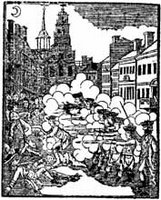 Normally around the 5th of March I write about the Boston Massacre, the events that led up to it and its aftermath. But I’ve been recounting a criminal trial from 1785 which is unconnected—or is it?
Normally around the 5th of March I write about the Boston Massacre, the events that led up to it and its aftermath. But I’ve been recounting a criminal trial from 1785 which is unconnected—or is it?Several of the figures in that burglary trial have links to the Massacre, showing the small size of pre-industrial Boston and the big impact of the violence on King Street.
Robert Treat Paine, the Massachusetts attorney general in 1785, was a special prosecutor in the Massacre trials. The town of Boston hired him when the royal attorney general, Jonathan Sewall, was looking reluctant.
James Lovell, the victim of the 1784 robbery, was the first man invited by Boston to orate on the Massacre, in April 1771. (Dr. Thomas Young had spoken on the anniversary of the killing at the Manufactory, but that was unofficial. The town took up the idea and ran with it until 1783.)
Defense attorney William Tudor was one of John Adams’s clerks during the Massacre trials. He delivered the anniversary oration in 1779.
Bartholomew Broaders was an elected constable in 1784 who helped to investigate the burglary. Back in 1770, he was one of the barber’s apprentices who got into an argument with Pvt. Hugh White in front of the Customs office, the incident that ballooned into the shooting.
Archibald McNeal, a witness to the burglary in 1784, might also have been a witness to the events of 1770. An Archibald McNeil, Jr., testified for the town report:
that on Saturday the third instant, about half an hour after four in the afternoon, the deponent with two apprentices were spinning at the lower end of Mr. McNeil’s ropewalk, three stout grenadiers, armed with bludgeons, came to them, and addressing the deponent said, You damn’d dogs, don’t you deserve to be kill’d? Are you fit to die?However, there was at least one other Archibald McNeal in pre-Revolutionary Boston, a baker who evacuated with the British troops in 1776, so this may not be the same man.
As for shopkeeper John Fullerton, also burglarized in 1784, he was one of the victims of the Great Fire of 1760. (Yes, I’ll get back to that story, too.)
No comments:
Post a Comment